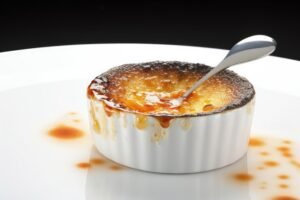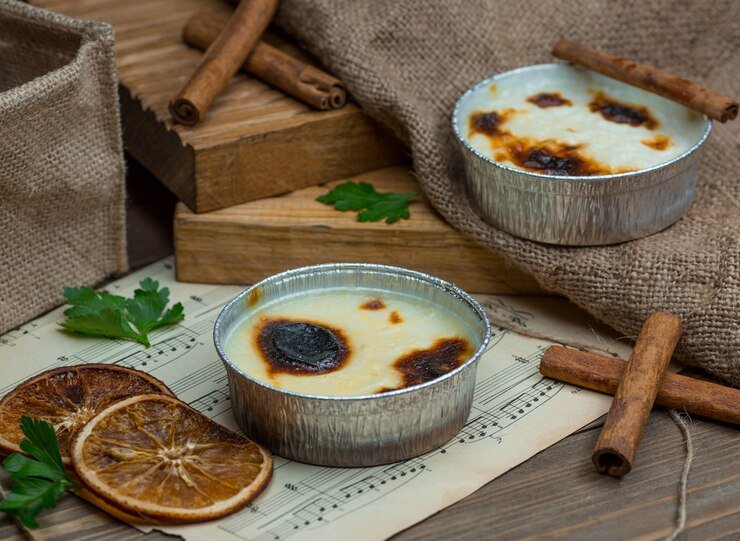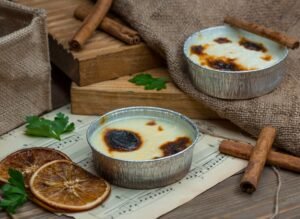Burnt cream, widely known as « crème brûlée, » is a popular dessert that originated in France. It consists of a rich, silky custard base that is typically flavored with vanilla, although other flavors like chocolate, coffee, and citrus can also be used. The distinguishing feature of this dessert is its caramelized sugar topping, which is achieved by sprinkling granulated sugar over the custard and then using a torch or broiler to melt and harden the sugar into a crisp, golden crust.
The dessert’s name, « crème brûlée, » translates to « burnt cream » in English, referring to the caramelization process. It is served in individual ramekins and is best enjoyed when the caramel is freshly hardened, offering a delightful contrast between the warm, brittle topping and the cool, creamy custard beneath. This dessert is a staple in French cuisine and has gained popularity worldwide, celebrated for its simplicity and elegance.
History and Origin of burnt cream
The origins of burnt cream are unclear, with France, England, and Spain all claiming it. The first known recipe was in François Massialot’s French cookbook « Le Cuisinier Royal et Bourgeois » from 1691. In England, it became famous as « burnt cream » at Trinity College, Cambridge, where they branded their crest into the caramel.
Why It Remains a Favorite Dessert Globally
burnt cream is loved worldwide for its rich and creamy texture contrasted by a crisp top. Its elegance and simplicity make it a favorite in both upscale and casual dining. Its ability to incorporate various flavors adds to its universal appeal. This dessert is not just a treat for the palate but also adds a touch of sophistication to any dining experience.
Basic Ingredients of burnt cream
Ingredients:
- 4 cups heavy cream
- 1 vanilla bean (or 2 teaspoons vanilla extract)
- 6 large egg yolks
- 1/2 cup granulated sugar, plus extra for the topping
- Hot water (for the baking dish)
Equipment:
- 6 ramekins (about 6-ounce size)
- 1 large baking dish
- Kitchen torch (optional, for caramelizing the sugar)
Instructions:
1. Preheat the Oven
- Preheat your oven to 325 degrees Fahrenheit (165 degrees Celsius).
2. Infuse the Cream
- Pour the heavy cream into a saucepan. Split the vanilla bean lengthwise and scrape out the seeds; add both the seeds and the pod to the cream.
- Slowly bring the cream to a simmer over medium heat. Once it starts to simmer, remove from the heat and let it sit for about 15 minutes to infuse the vanilla flavor.
3. Prepare the Egg Yolk Mixture
- In a bowl, whisk together the egg yolks and 1/2 cup of sugar until the mixture is smooth and the sugar has begun to dissolve.
4. Combine Cream and Yolks
- Remove the vanilla bean pod from the cream and slowly pour the cream into the egg yolk mixture, whisking constantly to prevent the eggs from curdling.
5. Prepare the Baking Dish
- Place the ramekins in a large baking dish and pour the cream mixture into the ramekins.
- Carefully pour hot water into the baking dish around the ramekins, about halfway up the sides of the ramekins.
6. Bake
- Bake in the preheated oven for about 40 to 45 minutes, or until the custards are just set but still slightly wobbly in the center.
7. Cool and Chill
- Remove the ramekins from the water bath and let them cool to room temperature. Once cooled, refrigerate for at least 2 hours, or until completely chilled.
8. Caramelize the Sugar
- Sprinkle a thin layer of granulated sugar over each custard. Use a kitchen torch to melt the sugar until it caramelizes evenly to form a hard, shiny top. If you don’t have a torch, you can place the ramekins under a broiler for a couple of minutes.
9. Serve
- Serve immediately after caramelizing the sugar to enjoy the crisp contrast with the creamy custard.
This classic dessert is elegant yet relatively simple to make, and it’s sure to impress your guests with its delightful texture and flavor contrast.
Techniques for the Perfect Caramelized Sugar Top
- Even Sugar Layer: Sprinkle a thin, even layer of sugar over the cooled custard.
- Use a Torch: Torch the sugar until it melts and turns golden brown. Move evenly to avoid burning spots.
- Let it Set: Allow the sugar to harden before serving to create the perfect crisp shell.
Common Mistakes and How to Avoid Them
- Overheating the Cream: Heat the cream just until hot to touch, not boiling.
- Curdling Eggs: Add hot cream slowly to the eggs while whisking vigorously to avoid cooking the eggs.
- Uneven Caramelization: Keep the torch moving in circles to evenly melt the sugar without burning.
This detailed guide will help you master the art of making Crème Brûlée, from the silky custard interior to the iconic sugary crust.
Nutritional Information of burnt cream
Health Aspects of burnt cream
Crème Brûlée is a decadent dessert that, while delicious, is high in calories and sugar. It’s important to consider its nutritional aspects, especially for those monitoring their intake for health reasons.
Caloric Content and Nutritional Breakdown
A typical serving of burnt cream can contain between 300 to 450 calories, depending on the size and specific ingredients used. The majority of these calories come from:
- Fats: Heavy cream is the primary ingredient, which is high in saturated fat. A single serving can contain up to 20 grams of fat.
- Sugars: With both sugar mixed into the custard and caramelized on top, a serving can have up to 20-30 grams of sugar.
Essential nutrients include:
- Protein: Provided by the egg yolks, each serving contains about 6 grams of protein.
- Vitamins and Minerals: Egg yolks are a good source of vitamin D, phosphorus, and B vitamins.
Discussing Dairy and Sugar Content
- Dairy: The heavy cream and eggs in Crème Brûlée provide calcium and protein but also contribute significant amounts of cholesterol and saturated fat. Those with dairy sensitivities or high cholesterol might need to limit their intake.
- Sugar: High sugar content can impact blood sugar levels, making it less ideal for diabetics or those trying to reduce sugar intake.
Moderation is key when enjoying Crème Brûlée, especially for those watching their caloric, fat, and sugar consumption. It can be a rich treat for special occasions but is best consumed in small quantities given its dense caloric makeup. For a healthier twist, alternatives like lower-fat cream or sugar substitutes can be used to decrease the calorie and sugar content without compromising too much on taste.
Serving and Storage Tips
Best Practices for Serving burnt cream
Crème Brûlée is as much about the presentation as it is about the taste. When serving this elegant dessert, keep the following tips in mind:
Presentation Tips
- Individual Servings: Serve burnt cream in individual ramekins to maintain the integrity of each portion’s caramelized top.
- Garnishing: Add a touch of elegance with a garnish like a mint leaf, a few fresh berries, or a light dusting of powdered sugar.
- Temperature: Serve burnt cream at room temperature or slightly chilled to ensure the custard is set but not too firm.
Pairing with Beverages and Other Desserts
- Beverages: Pair Crème Brûlée with a dessert wine like Sauternes, or a fortified wine such as Port, which complements the sweetness of the dessert. Coffee or espresso also pairs wonderfully, offering a bitter contrast to the sweetness.
- Other Desserts: To create a dessert platter, accompany burnt cream with lighter items like fruit sorbets or delicate cookies which won’t overpower its subtle vanilla flavor.
Storage Advice
Proper storage is key to maintaining the quality and texture of Crème Brûlée, especially if preparing it ahead of an event.
How to Store burnt cream
- Refrigeration: Once cooked, burnt cream should be cooled at room temperature and then refrigerated. It should be covered tightly with plastic wrap to avoid absorbing any odors from the fridge and to prevent moisture from ruining the surface.
- Shelf Life: Properly stored,burnt cream can last in the refrigerator for up to two days before the quality begins to deteriorate.
Tips on Making Ahead for Events
- Prepare in Advance: The custard can be prepared and cooked in ramekins up to two days ahead. Keep them refrigerated and uncovered until you are ready to add the sugar topping.
- Caramelizing the Top: Perform the caramelization of the sugar top just before serving. This ensures the sugar crust is crisp and fresh, providing the classic texture contrast that is so delightful in Crème Brûlée.
By following these serving and storage tips, you can ensure that your Crème Brûlée is not only delicious but also beautifully presented and well-preserved for any occasion.

Advanced Techniques and Variations
Creative Variations of Crème Brûlée
Experimenting with different flavors can transform the traditional Crème Brûlée into a novel dessert that captivates any palate:
- Seasonal Variations: For a fall treat, Pumpkin Spice Crème Brûlée incorporates pumpkin puree and spices like cinnamon and nutmeg. During summer, try a Lemon Basil version for a fresh twist.
- Unique Flavors: Infuse the cream with aromatic elements such as lavender or rosemary for a floral take. Citrus zest or chocolate can be added to the custard for a zesty or decadent version.
Professional Tips for Mastering Crème Brûlée
Achieving the perfect burnt cream involves precision and some professional techniques:
- Using a Torch vs. Broiler: A torch gives more control over caramelization, allowing you to evenly melt the sugar without heating the custard. A broiler, while effective, requires careful watching to prevent burning.
- Perfect Texture: The custard should be just set, with a slight wobble in the center. Slow cooking in a water bath (bain-marie) helps achieve this consistency without curdling.
FAQs
Addressing common questions can help troubleshoot and enhance the Crème Brûlée making experience:
-
1. What is burnt cream?
Burnt cream, known as crème brûlée in French, is a dessert consisting of a rich, creamy custard base topped with a layer of hard, caramelized sugar. It is renowned for its contrasting textures and elegant simplicity.
2. What are the basic ingredients of burnt cream?
The basic ingredients include heavy cream, egg yolks, sugar, and vanilla. The vanilla can be substituted or complemented with other flavorings such as citrus zest, chocolate, or coffee.
3. How do you achieve the caramelized top?
The caramelized top is achieved by sprinkling granulated sugar over the cooled custard and then using a kitchen torch to melt and brown the sugar. If a torch isn’t available, the sugar can also be caramelized under a broiler.
4. Can burnt cream be made in advance?
Yes, burnt cream can be prepared up to two days in advance and stored in the refrigerator. However, the sugar topping should be added and caramelized just before serving to ensure it retains its crisp texture.
5. Are there any common variations of burnt cream?
Common variations involve adding different flavors to the custard, such as chocolate, raspberry, or coffee. Some recipes might use alternative dairy options like half-and-half or coconut milk for different textures or dietary needs.
6. How do I prevent the custard from curdling?
To prevent the custard from curdling, heat the cream gently and temper the egg yolks by gradually adding some of the warm cream to them before combining everything. It’s also crucial to cook the custard at a low temperature.
7. What’s the best way to serve burnt cream?
Burnt cream is best served slightly chilled or at room temperature, with the caramelized sugar freshly prepared for the best texture contrast. It can be garnished with fresh berries or a sprig of mint for an added touch of elegance.
8. How do you know when the custard is perfectly cooked?
The custard should be cooked until just set but still slightly wobbly in the center. Overcooking can lead to separation and a less creamy texture. A water bath during baking helps regulate the temperature and ensure even cooking.
External Links and Recommended Anchor Text:
Certainly! Here are clickable links to find recipes for burnt cream, or crème brûlée:
- Epicurious – Classic Crème Brûlée Recipe
- Find a traditional crème brûlée recipe with expert tips for achieving the perfect caramelized topping.
- AllRecipes – How to Make Crème Brûlée
- This guide from AllRecipes offers a step-by-step approach to making crème brûlée, complete with user reviews and helpful modifications.
These clickable links provide valuable resources for both beginners and experienced cooks interested in making this elegant dessert.
conclusion
In conclusion, burnt cream, better known as crème brûlée, epitomizes the perfect blend of simplicity and elegance in a dessert. Its rich, smooth custard paired with a crunchy, caramelized top offers a delightful contrast in textures that has won the hearts of dessert lovers around the world. Whether infused with classic vanilla or an inventive new flavor, crème brûlée remains a timeless favorite, celebrated for its sophisticated yet straightforward charm. Whether you’re a novice baker or a seasoned chef, mastering this dish can add a touch of class to any dining experience.


